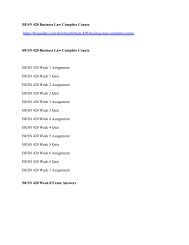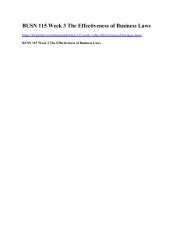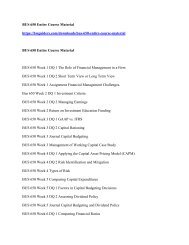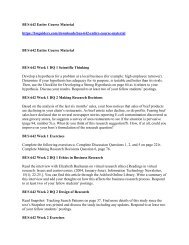BUS 430 Assignment 2 Inventory Management
You also want an ePaper? Increase the reach of your titles
YUMPU automatically turns print PDFs into web optimized ePapers that Google loves.
<strong>BUS</strong> <strong>430</strong> <strong>Assignment</strong> 2 <strong>Inventory</strong> <strong>Management</strong><br />
https://hwguiders.com/downloads/bus-<strong>430</strong>-assignment-2-inventory-management/<br />
<strong>BUS</strong> <strong>430</strong> <strong>Assignment</strong> 2 <strong>Inventory</strong> <strong>Management</strong><br />
Due Week 8 and worth 300 points<br />
Research two (2) manufacturing or two (2) service companies that manage inventory and<br />
complete this assignment.<br />
Write a six to eight (6-8) page paper in which you:<br />
1. Determine the types of inventories these companies currently manage and describe their<br />
essential inventory characteristics.<br />
2. Analyze how each of their goods and service design concepts are integrated.<br />
3. Evaluate the role their inventory plays in the company’s performance, operational<br />
efficiency, and customer satisfaction.<br />
4. Compare and contrast the four (4) different types of layouts found with each company;<br />
explain the importance of the layouts to the company’s manufacturing or service<br />
operations.<br />
5. Determine at least two (2) metrics to evaluate supply chain performance of the<br />
companies; suggest improvements to the design and operations of their supply chains<br />
based on those metrics.<br />
6. Suggest ways to improve the inventory management for each of the companies without<br />
affecting operations and the customer benefit package. Provide a rationale to support the<br />
suggestion.<br />
7. Use at least three (3) quality resources in this assignment. Note: Wikipedia and similar<br />
Websites do not qualify as quality resources.
Your assignment must follow these formatting requirements:<br />
<br />
<br />
Be typed, double spaced, using Times New Roman font (size 12), with one-inch margins<br />
on all sides; citations and references must follow APA or school-specific format. Check<br />
with your professor for any additional instructions.<br />
Include a cover page containing the title of the assignment, the student’s name, the<br />
professor’s name, the course title, and the date. The cover page and the reference page are<br />
not included in the required assignment page length.<br />
The specific course learning outcomes associated with this assignment are:<br />
<br />
<br />
<br />
<br />
<br />
<br />
<br />
Evaluate the processes used in designing and producing goods and services.<br />
Determine four layout patterns and when they should be used.<br />
Utilize the concept of supply chain management.<br />
Employ the concept of capacity management.<br />
Evaluate the management of inventories and resources.<br />
Use technology and information resources to research issues in operations management.<br />
Write clearly and concisely about operations management using proper writing<br />
mechanics.<br />
Grading for this assignment will be based on answer quality, logic / organization of the paper,<br />
and language and writing skills, using the following rubric.<br />
Points: 300 <strong>Assignment</strong> 2: <strong>Inventory</strong> <strong>Management</strong><br />
Criteria Unacceptable Meets Fair Proficient Exemplary
1. Determine the types<br />
of inventories these<br />
companies currently<br />
manage and describe<br />
their essential<br />
inventory<br />
characteristics.Weight:<br />
10%<br />
2. Analyze how each<br />
of their goods and<br />
service design<br />
concepts are<br />
integrated.<br />
Weight: 15%<br />
3. Evaluate the role<br />
their inventory plays<br />
in the company’s<br />
performance,<br />
operational efficiency,<br />
and customer<br />
satisfaction.Weight:<br />
15%<br />
4. Compare and<br />
contrast the four (4)<br />
different types of<br />
layouts found with<br />
each company; explain<br />
Below 60% F Minimum<br />
Expectations60-<br />
69% D<br />
70-79% C 80-89% B 90-100% A<br />
Did not submit<br />
or<br />
incompletely Insufficiently<br />
Partially Satisfactorily Thoroughly<br />
determined the<br />
types of<br />
inventories<br />
these<br />
companies<br />
currently<br />
manage; Did<br />
not submit or<br />
incompletely<br />
described their<br />
essential<br />
inventory<br />
characteristics.<br />
Did not submit<br />
or<br />
incompletely<br />
analyzed how<br />
each of their<br />
goods and<br />
service design<br />
concepts are<br />
integrated.<br />
Did not submit<br />
or<br />
incompletely<br />
evaluated the<br />
role their<br />
inventory<br />
plays in the<br />
company’s<br />
performance,<br />
operational<br />
efficiency, and<br />
customer<br />
satisfaction.<br />
Did not submit<br />
or<br />
incompletely<br />
compared and<br />
contrasted the<br />
determined the<br />
types of<br />
inventories these<br />
companies<br />
currently<br />
manage;<br />
Insufficiently<br />
described their<br />
essential<br />
inventory<br />
characteristics.<br />
Insufficiently<br />
analyzed how<br />
each of their<br />
goods and<br />
service design<br />
concepts are<br />
integrated.<br />
Insufficiently<br />
evaluated the<br />
role their<br />
inventory plays<br />
in the company’s<br />
performance,<br />
operational<br />
efficiency, and<br />
customer<br />
satisfaction.<br />
Insufficiently<br />
compared and<br />
contrasted the<br />
four (4) different<br />
types of layouts<br />
determined the<br />
types of<br />
inventories<br />
these<br />
companies<br />
currently<br />
manage;<br />
Partially<br />
described their<br />
essential<br />
inventory<br />
characteristics.<br />
Partially<br />
analyzed how<br />
each of their<br />
goods and<br />
service design<br />
concepts are<br />
integrated.<br />
Partially<br />
evaluated the<br />
role their<br />
inventory<br />
plays in the<br />
company’s<br />
performance,<br />
operational<br />
efficiency, and<br />
customer<br />
satisfaction.<br />
Partially<br />
compared and<br />
contrasted the<br />
four (4)<br />
different types<br />
determined the determined the<br />
types of types of<br />
inventories inventories<br />
these these<br />
companies companies<br />
currently currently<br />
manage; manage;<br />
Satisfactorily Thoroughly<br />
described their described their<br />
essential essential<br />
inventory inventory<br />
characteristics. characteristics.<br />
Satisfactorily<br />
analyzed how<br />
each of their<br />
goods and<br />
service design<br />
concepts are<br />
integrated.<br />
Satisfactorily<br />
evaluated the<br />
role their<br />
inventory<br />
plays in the<br />
company’s<br />
performance,<br />
operational<br />
efficiency, and<br />
customer<br />
satisfaction.<br />
Satisfactorily<br />
compared and<br />
contrasted the<br />
four (4)<br />
different types<br />
Thoroughly<br />
analyzed how<br />
each of their<br />
goods and<br />
service design<br />
concepts are<br />
integrated.<br />
Thoroughly<br />
evaluated the<br />
role their<br />
inventory<br />
plays in the<br />
company’s<br />
performance,<br />
operational<br />
efficiency, and<br />
customer<br />
satisfaction.<br />
Thoroughly<br />
compared and<br />
contrasted the<br />
four (4)<br />
different types
the importance of the<br />
layouts to the<br />
company’s<br />
manufacturing or<br />
service<br />
operations.Weight:<br />
15%<br />
5. Determine at least<br />
two (2) metrics to<br />
evaluate supply chain<br />
performance of the<br />
companies; suggest<br />
improvements to the<br />
design and operations<br />
of their supply chains<br />
based on those<br />
metrics.Weight: 15%<br />
6. Suggest ways to<br />
improve the inventory<br />
management for each<br />
of the companies<br />
without affecting<br />
operations and the<br />
customer benefit<br />
package. Provide a<br />
rationale to support the<br />
four (4)<br />
different types<br />
of layouts<br />
found with<br />
each company;<br />
Did not submit<br />
or<br />
incompletely<br />
explained the<br />
importance of<br />
the layouts to<br />
the company’s<br />
manufacturing<br />
or service<br />
operations.<br />
Did not submit<br />
or<br />
incompletely<br />
determined at<br />
least two (2)<br />
metrics to<br />
evaluate<br />
supply chain<br />
performance<br />
of the<br />
companies;<br />
Did not submit<br />
or<br />
incompletely<br />
suggested<br />
improvements<br />
to the design<br />
and operations<br />
of their supply<br />
chains based<br />
on those<br />
metrics.<br />
Did not submit<br />
or<br />
incompletely<br />
suggested<br />
ways to<br />
improve the<br />
inventory<br />
management<br />
for each of the<br />
found with each<br />
company;<br />
Insufficiently<br />
explained the<br />
of layouts<br />
found with<br />
each company;<br />
Partially<br />
importance of explained the<br />
the layouts to the importance of<br />
company’s<br />
manufacturing<br />
or service<br />
operations.<br />
Insufficiently<br />
determined at<br />
least two (2)<br />
metrics to<br />
evaluate supply<br />
chain<br />
performance of<br />
the companies;<br />
Insufficiently<br />
suggested<br />
improvements to<br />
the design and<br />
operations of<br />
their supply<br />
chains based on<br />
those metrics.<br />
Insufficiently<br />
suggested ways<br />
to improve the<br />
inventory<br />
management for<br />
each of the<br />
companies<br />
without affecting<br />
operations and<br />
the layouts to<br />
the company’s<br />
manufacturing<br />
or service<br />
operations.<br />
Partially<br />
determined at<br />
least two (2)<br />
metrics to<br />
evaluate<br />
supply chain<br />
performance<br />
of the<br />
companies;<br />
Partially<br />
suggested<br />
improvements<br />
to the design<br />
and operations<br />
of their supply<br />
chains based<br />
on those<br />
metrics.<br />
Partially<br />
suggested<br />
ways to<br />
improve the<br />
inventory<br />
management<br />
for each of the<br />
companies<br />
without<br />
of layouts of layouts<br />
found with found with<br />
each company; each company;<br />
Satisfactorily Thoroughly<br />
explained the explained the<br />
importance of importance of<br />
the layouts to the layouts to<br />
the company’s the company’s<br />
manufacturing manufacturing<br />
or service or service<br />
operations. operations.<br />
Satisfactorily<br />
determined at<br />
least two (2)<br />
metrics to<br />
evaluate<br />
supply chain<br />
performance<br />
of the<br />
companies;<br />
Satisfactorily<br />
suggested<br />
improvements<br />
to the design<br />
and operations<br />
of their supply<br />
chains based<br />
on those<br />
metrics.<br />
Satisfactorily<br />
suggested<br />
ways to<br />
improve the<br />
inventory<br />
management<br />
for each of the<br />
companies<br />
without<br />
Thoroughly<br />
determined at<br />
least two (2)<br />
metrics to<br />
evaluate<br />
supply chain<br />
performance<br />
of the<br />
companies;<br />
Thoroughly<br />
suggested<br />
improvements<br />
to the design<br />
and operations<br />
of their supply<br />
chains based<br />
on those<br />
metrics.<br />
Thoroughly<br />
suggested<br />
ways to<br />
improve the<br />
inventory<br />
management<br />
for each of the<br />
companies<br />
without
suggestion.Weight:<br />
15%<br />
7. 3 referencesWeight:<br />
5%<br />
8. Clarity, writing<br />
mechanics, and<br />
formatting<br />
requirementsWeight:<br />
10%<br />
companies<br />
without<br />
affecting<br />
operations and<br />
the customer<br />
benefit<br />
package. Did<br />
not submit or<br />
incompletely<br />
provided a<br />
rationale to<br />
support the<br />
suggestion.<br />
No references<br />
provided<br />
More than 8<br />
errors present<br />
the customer<br />
benefit package.<br />
Insufficiently<br />
provided a<br />
rationale to<br />
support the<br />
suggestion.<br />
Does not meet<br />
the required<br />
number of<br />
references; all<br />
references poor<br />
quality choices.<br />
7-8 errors<br />
present<br />
affecting<br />
operations and<br />
the customer<br />
benefit<br />
package.<br />
Partially<br />
provided a<br />
rationale to<br />
support the<br />
suggestion.<br />
Does not meet<br />
the required<br />
number of<br />
references;<br />
some<br />
references<br />
poor quality<br />
choices.<br />
5-6 errors<br />
present<br />
affecting<br />
operations and<br />
the customer<br />
benefit<br />
package.<br />
Satisfactorily<br />
provided a<br />
rationale to<br />
support the<br />
suggestion.<br />
Meets number<br />
of required<br />
references; all<br />
references<br />
high quality<br />
choices.<br />
3-4 errors<br />
present<br />
affecting<br />
operations and<br />
the customer<br />
benefit<br />
package.<br />
Thoroughly<br />
provided a<br />
rationale to<br />
support the<br />
suggestion.<br />
Exceeds<br />
number of<br />
required<br />
references; all<br />
references<br />
high quality<br />
choices.<br />
0-2 errors<br />
present

















